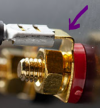This was one of the main reasons when I first set out designing the lineup back in 2020 I made sure no soldering was involved: the ability for the end user to either “repair/replace” parts easily if necessary. Along with the ability to upgrade if wanted (such as to a Rack case, etc) without needing to send back to me.
The Fastons are a great, secure connection. Closing in on 1000 total sales orders and never had one slip off during shipment or use. Aside from the steel tab issue, their performance is no different from soldering.
Can add a bit more about the Fastons:
- I bypassed the Faston by soldering to the binding post tab and it does not fix the distortion issue.
- They are more consistent than soldering. Most notably, soldering to a large metal mass like the binding post can result in cold solder joints or solder potentially spreading on to threads and making it difficult to replace a binding post.
- Since it does take a good bit of heat to solder to the binding post, you can also melt the wire’s insulation or the plastic insulating washer. Have done both with the bigger posts so am speaking from experience.
Last edited:

